Abstract
The use of construction waste for concrete is an effective way to reduce the environmental burden while improving the sustainability of construction materials. Nano-SiO2 (NS) has excellent volcanic ash activity, which can effectively improve the strength of concrete. In this study, the synergistic effects of NS and 30% recycled concrete aggregate (RCA) on the mass loss, compressive strength, ultrasonic sound velocity values and microstructure of RAC after 25, 50, 75 and 100 repetitions of a dry–wet cycle (DWC) of sulfuric acid were investigated. The results show that NS has a significant role in improving RAC performance. The RAC specimens showed the lowest mass loss rate, the highest compressive strength, the lowest ultrasonic velocity value and the best resistance to sulfate erosion when the NS doping was 4%. Meanwhile, under CT and SEM, RAC with NS has lower porosity and higher hydration, which can effectively inhibit the crack generation and has stable volume growth within 0–50 repetitions of DWC. In addition, the addition of NS improves not only the microstructure of the substrate but also the interfacial transition zone (ITZ). When 4% NS was added, the porosity was the lowest and the durability improvement was the best performance. This study not only improves the production performance of RAC but also provides a strong reference for the integrated application of nanomaterials in concrete.
1. Introduction
Over the past decade or so, the amount of construction waste has been on the rise. Many researchers have conducted numerous studies on the applicability of construction waste in construction projects [1,2,3,4,5,6,7]. RAC is a green concrete that replaces natural concrete aggregates (NCA) with some or all RCA to achieve sustainable building materials. Research on RAC has been conducted for quite a long time, and many scientists have achieved many meaningful results in their research, such as the basic performance and durability of RAC and the seismic performance study of recycled concrete composite structures [8,9]. Duan et al. [10] studied recycled concrete through experiments, recycled concrete and decayed slag after the production of ordinary concrete or high-performance concrete block aggregate concrete and lightweight aggregates; the strength of recycled concrete can reach C30 to meet the requirements of the project on strength.
However, Feng et al. [11] predicted the thermomechanical properties of rubber-modified recycled aggregate concrete, and the test results showed that the RCA substitution rate was negatively correlated with the uniaxial compressive strength, but the addition of RCA was effective in reducing the strength loss of concrete after high-temperature treatment. Similar conclusions were obtained by Tang et al. [12]. Subsequently, Feng et al. [13] suggested that the flowability of seawater and sea sand recycled aggregate concrete was lower than that of RAC for the same water/cement ratio, and the substitution rate of RCA had a greater effect on the concrete than the mixture of seawater and sea sand.
In addition, in cold marine environments, seawater immersion has a significant negative impact on concrete buildings, and building structures in northeastern China, the United States, and coastal Canada are suffering from sulfate attacks. Therefore, studying the ability of concrete to resist sulfate attack will be beneficial to improve the safety and durability of building structures in salt-frozen areas. NS can improve the mechanical properties of concrete, so the study of NSRAC can not only solve the environmental problems caused by RCA but also add a practical reference for the durability study of NS-modified concrete, which actually effectively helps to improve the stability of building structures in salt-frozen areas.
Rahimzadeh et al. [14] compared the strength of cement mortar blended with micro-silica and nano-silica by modeling and found that nano-silica enhanced the compressive strength of cement mortar better than microsilica by 6.3%. Huang et al. [15] increased the 28-day strength of concrete by about 19% using 5% nano powder at the same water/cement ratio. Gao et al. [16] found experimentally that NS can optimize the pore structure of light-aggregate concrete and improve the seepage resistance of concrete. Li et al. [17] showed through their study that the addition of nano-silica to shale concrete can improve the segregation resistance of concrete and the flowability of the mix to some extent. Li et al. [18] studied the dynamic properties of nanomaterials at different traction rates and determined the stress-tension curves of nanomaterials. The results hair showed that the impact force of concrete increased and the deformation performance was good after adding nanomaterials to ordinary concrete, which was about 1% of that of ordinary concrete.
Experimental studies of a large number of applications have shown that the addition of nanomaterials within a certain range can effectively improve the strength of concrete, and that an ideal amount exists. Zhu et al. [19] investigated the effect of 0%, 2%, 5% and 5% NS on the strength of fly ash bauxite concrete and found that the strength of the concrete gradually increased with the increase of NS content, and the strength of the concrete mixed with 5% and 20% was greater than that of the concrete mixed with 0%. Ali et al. [20] stated that concrete with NS added can have up to 25% higher compressive strength than normal concrete, and 420 data results showed that the optimum admixture of NS is 1–5%. In addition, the higher NS admixture in the normal range effectively improves the compressive strength of concrete. Huo et al. [21] investigated the effect of NS on the strength of lightweight concrete, and the strength of concrete increased with increasing NS content when the NS content was between 0% and 2%. Faraj et al. [22] modeled and predicted the compressive strength of nano-silica-modified self-compacting concrete and showed that a small amount of NS can positively modify the strength and other properties of self-compacting concrete (SSC). However, percentages higher than 2% may have a negative impact on SSC performance. Li et al. [23] studied the addition of nanomaterials to concrete, and when the dosage was 3%, there was a contribution to the improvement of concrete strength with a growth rate of about 4%. Meanwhile, Ahmed et al. [24] found that the addition of NS improved the microstructural characteristics and formed additional geopolymeric products compared to geopolymer concrete. Experiments showed that the 3% admixture of NS showed the greatest improvement in compressive strength of concrete with 6.3, 13.4, 20.5, 21 and 21.9% at 3, 7, 28, 90 and 180 days, respectively.
Nanomaterials improve the efficiency of concrete use. However, there is no unified conclusion on the mechanism of NS-modified concrete. This study hopes to provide more explanation and speculation on the mechanism based on the existing nano-modified concrete. Based on these findings, the amount of NS used is one of the most important factors affecting the mechanical properties and durability of nano-SiO2-modified recycled concrete (NSRAC). In order to further infer that the addition of NS to RAC can effectively cope with sulfate erosion in cold regions, it is essential to conduct a series of tests on NSRAC to understand its performance and damage mechanism.
This study is based on the effect of DWC of sulfate and aims to analyze the mechanism of performance enhancement of RAC with NS at different substitution rates, i.e., to determine the effect of NS admixture (0%, 2%, 4%, 6%, 8%, 10%) and RCA substitution rates (0%, 30%) on the mechanical properties and durability of concrete. The main content of the experimental study is to analyze the mass loss rate, residual compressive strength, and ultrasonic sound velocity value through the tests, and to analyze the NSRAC resistance to sulfate based on the preliminary analysis of the surface phenomenon and then to analyze the refined aspects of the NS to RAC resistance to sulfate through CT and SEM, and then to draw conclusions about the modified recycled concrete. In addition, this study provides a reference for engineering applications, and the ratio and test results can further help the in-depth study of NSRAC in the future.
The remaining sections are organized as follows: Section 2 describes the physical properties of the raw materials and the preparation of NSRAC and explains the test methods, procedures, and durability evaluation methods. Further test conclusions and discussion of NSRAC are given in Section 3. Finally, the conclusions and limitations of the study are presented in Section 4.
2. Experimental Methodology
2.1. Raw Materials and Mix Procedures
The NS used in this study was produced by Shanghai Meikun Chemical (Group) Co. The morphology of NS is microporous white powder, and the main material indexes are shown in Table 1. The ordinary silicate cement P.O 42.5R used is produced by China Shaanxi Xi’an Qinling Cement (Group) Co., Ltd. and conforms to Chinese national standard GB 175-2007, and the chemical composition and main physical indexes of the cement are shown in Table 2 and Table 3, respectively. RCA are waste aggregates such as beams and columns selected from demolished pieces of C30 commercial concrete buildings that meet the requirements. The treated aggregates are very large, about 100 mm in diameter and are crushed by an artificial crusher to obtain RCA of 5–30 mm in diameter. The RCA and NCA grading curves are shown in Figure 1. After crushing, a simple manual inspection is required, first of all, and some impurities and residues should be removed, classified, and evaluated according to the test requirements, and if they do not meet the requirements, they should be removed in time, and before reaching the test requirements, they should be crushed again until they reach the test requirements [25]. The main technical specifications of NCA and RCA are compared in Table 4.

Table 1.
Nanomaterial parameter performance index.

Table 2.
Chemical composition index of cement (unit: %).

Table 3.
Physical properties of cement index.

Figure 1.
NCA and RCA sieve curves.

Table 4.
Performance indicators of recycled and natural aggregates.
Water-reducing agent is yellow-brown powder; the main component is β-naphthalene sulfonic acid sodium formaldehyde condensate, a chemically synthesized naphthalene high-efficiency water-reducing agent, with specification FDN-C, which is produced by China Shandong Huaifang Wanshan Group Co., Ltd. Its use complies with the Chinese national standard GB 50119-2013 [26]. It has a strong dispersion effect on cement particles and can improve or enhance the comprehensive performance of various concretes.
The purpose of this test is to investigate the effect of different doping levels of NS on the resistance of RAC to sulfate attack. Numerous practices have shown that the performance of RAC is basically similar to that of natural aggregate concrete (NAC) when the RCA substitution rate is less than 30% [27]. Therefore, in this study, 30% RCA was selected to replace NCA and concrete specimens with different NS replacement rates were cast according to the requirements of the mixing ratio. The NS substitution rates used for the experimental design were 0%, 2%, 4%, 6%, 8% and 10% in order to make the test accurate, and 12 test blocks (size 100 mm × 100 mm × 100 mm) were used for each ratio. According to the Chinese concrete quality control standard GB 50164-2011 [28], the same actual water/cement ratio W/C = 0.40 was used for all test subjects. The water adsorbed due to the large porosity of the recycled aggregates should also be considered during the concrete mixing process so that the water consumption for the same water/cement ratio can be calculated for each group of test blocks. The mix ratio of RAC in Table 5 was designed with seven mixes. The materials were accurately weighed and poured into a double horizontal axis concrete mixer for 3 min to make a uniform distribution of the materials, and then a mixture of water and water-reducing agent was slowly added to the mix, followed by filling the mold and dense vibrating, demolding after 1 day in a laboratory environment and curing for 28 days in a laboratory environment. Photographs of raw materials and specimen preparation are shown in Figure 2.

Table 5.
Matching ratio design of RAC.

Figure 2.
Photos of raw materials and specimen preparation.
2.2. Test Methods
In this study, the specimen mass loss, residual compressive strength and ultrasonic sound velocity loss of concrete were used to evaluate the durability of NSRAC. The effects of different NS substitution rates on the durability of NSRAC after DWC in sulfate were investigated, and the microscopic morphology of concrete after DWC was analyzed by CT and SEM, and Figure 3 shows the flow chart followed in this study.
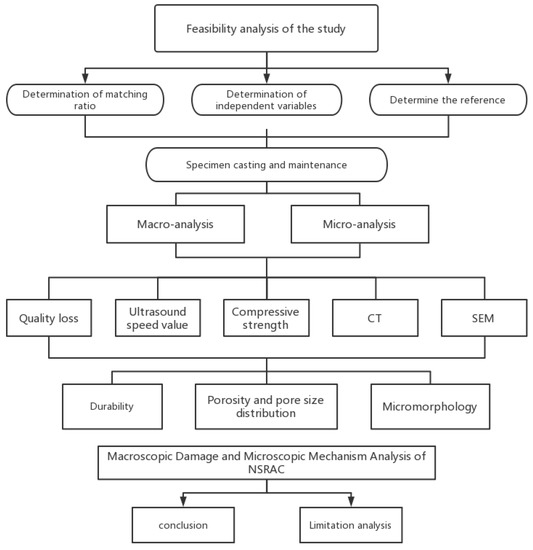
Figure 3.
The flowchart process followed in this study.
2.2.1. DWC
In order to study the different conditions exhibited by the degree of sulfate attack on concrete, the DWC method was used, which greatly reduced the test schedule. The dry and wet cycle test of concrete against sulfate corrosion used in this experiment was conducted according to the Chinese national standard GB/T 11975 [29] and the American ASTM 1012 standard. The circulating system was soaked in 15% Na2SO4 solution at room temperature for 16 h, removed and cooled and dried for 1 h, dried in an oven at 80 °C for 6 h, cooled and dried for 1 h and then weighed or compressed for strength. One cycle is 24 h. Then it was placed in a 15% Na2SO4 solution. Immersion in the 15% Na2SO4 solution (Figure 4) showed the most visualized degree of corrosion on the concrete.
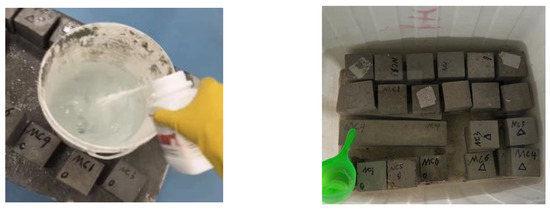
Figure 4.
Soaking in 15% Na2SO4 solution.
2.2.2. Ultrasonic Sound Velocity Value Test
In accordance with CECS 02-2005 C.F.R. [30] technical regulations for testing the compressive strength of concrete by ultrasonic rebound synthesis method, a non-metallic ultrasonic testing analyzer was used, as shown in Figure 5, and the relative surface perpendicular to the pouring surface was selected as the ultrasonic testing area. On opposite test surfaces, three test points were drawn diagonally, and to ensure good test results, a layer of butter was applied to the test points. In the corresponding designated test points, so that the transmitter and receiver can be smoothly opposed, the two sensors are always kept on the same axis; if the test points are found to have protruding mortar, they should be cleaned up immediately, otherwise there is a direct impact on the test results. The measured sound velocity value of each test block should be carried out one by one from top to bottom, and the results should be recorded three times at each point, and finally, the average value should be obtained and then divided by the width of the test piece L (L = 150 mm) to obtain the sound velocity value, and two valid digits can be retained after the decimal point. The relative dynamic modulus of elasticity is measured indirectly by the propagation velocity of ultrasonic waves in the specimen, and the RDEM is calculated by equation using a non-contact ultrasonic measuring instrument. RDEM was measured every 25 repetitions of DWC.
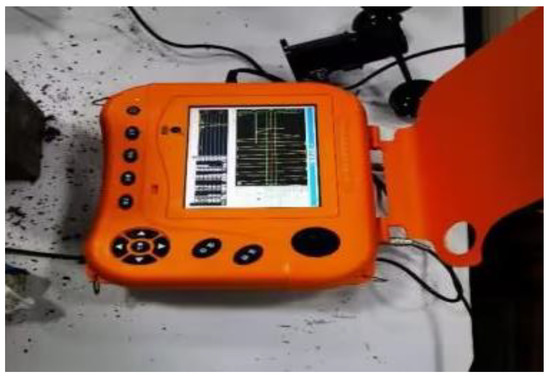
Figure 5.
Non-metallic ultrasonic detection analyzer.
2.2.3. Cubic Compressive Strength Test
According to the requirements of Chinese National Standard GB/T 50081 [31], a WAW-1000 kN universal testing machine was used. The loading speed was 0.5 Mpa/s. The cube size was 100 mm × 100 mm × 100 mm, and the results were taken as the average of three test blocks for each ratio. The cube compressive strength testing device is shown in Figure 6.
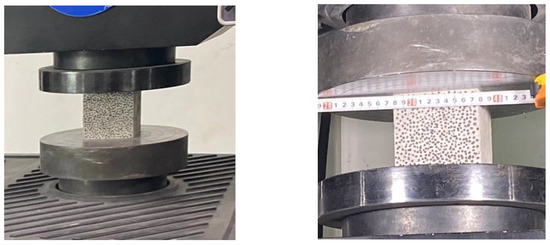
Figure 6.
Cubic compressive strength testing device.
When used as a parameter in the experiment, seven different groups of NS substitution rates were found, and a blank control group was designed for comparison. Throughout the DWC, a group of specimens (20) was randomly selected, and specimens were ultrasonically tested and strength tested once every 25 repetitions of DWC. The test groups are detailed in Table 6.

Table 6.
Grouping of test pieces.
3. Results and Discussion
3.1. Quality Loss
Concrete is evaluated in terms of quality loss rate as a reference. Concrete becomes unconsolidated due to deepening erosion, cement mortar gradually separates from the aggregate so that the mass of concrete is reduced, and the ratio of the mass of cement mortar to the total mass of the concrete block is the value of the mass loss rate. The change in mass loss of the specimens at different number of repetitions of DWC is shown in Figure 7.
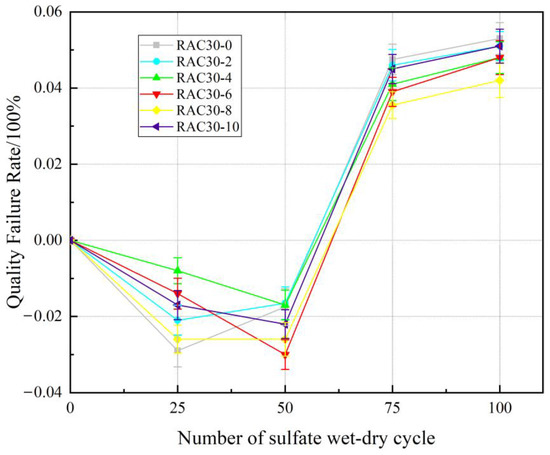
Figure 7.
Variation of mass loss rate of test blocks under different number of DWC repetitions.
The mass loss rates of RAC with different NS doping during the DWC are shown in Figure 7. It can be seen that during the DWC, the mass of the concrete specimens of the six mixes increased and then decreased with the increase of NS admixture. In 25 repetitions of the DWC of sulfate, the pores inside the specimen are filled and the volume expands due to the gel-like object generated when the calcium substance in the cement interacts with the sulfate. With the increasing number of repetitions of DWC, the mass of RAC30-6 also increased gradually, and after 50 repetitions of DWC, the mass of RAC with NS added was larger than that of ordinary RAC, in which the mass of RAC30-6 was obviously larger than that of other specimens. This is because nanomaterials can fill microgaps and cracks in concrete more. As new products are deposited in the concrete, the quality of concrete of other nanomaterials decreases substantially. And due to the gradual loss of internal stress, it makes the width of internal cracks and side cracks of concrete specimen expand, and after the reaction deepens, the internal pressure reaches the extreme, the cracks penetrate the specimen, and the specimen reaches complete damage.
Figure 8 shows that the appearance of RAC with 4% NS doping is least affected by sulfate corrosion at 25 repetitions of DWC. The analysis of the curves shown in Figure 9 shows that the strength of RAC30-4 reaches its maximum value when the number of repetitions of DWC number 25, while the strength of concrete mixed with nanomaterials has been in a growing trend, so the effect of hydration on concrete is much greater than that of sulfate, and the effect of DWC on concrete forces still exists. The more repetitions of DWC, the more severe the corrosion of the concrete will be. This is mainly because recycled concrete is a material with pores which form tiny cracks during the hydration process, and RAC forms a large number of tiny cracks in the concrete after DWC. With the increase in the number of repetitions of DWC, internal cracks continue to expand, eventually affecting performance. Therefore, the compressive strength of concrete with different NS contents started to decrease with deepening corrosion, but the compressive strength of RAC30-4 decreased slowly, and the final strength of other concrete with added NS was much lower than that of RAC30-4. This is due to the fact that the new cement paste consisting of 4% NS and 30% recycled aggregates achieves an optimal combination of particles and thus a high filling density.

Figure 8.
Comparison of appearance after 25 repetitions cube compressive test in DWC.
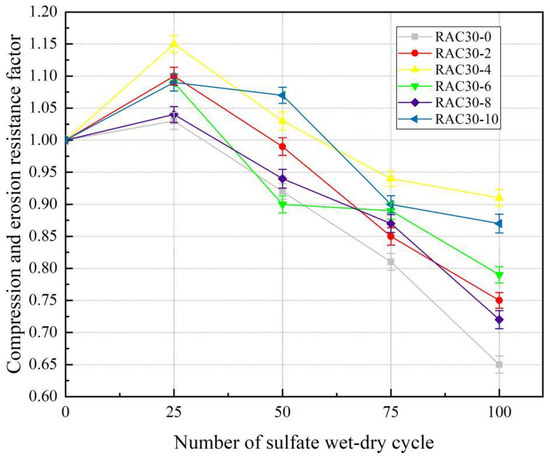
Figure 9.
Variation of compressive corrosion resistance coefficient of test blocks under different number of DWC repetitions.
The results of this study are consistent with the findings of Ali et al. [20], who found that 1–5% NS can enhance the compressive strength of concrete.
3.2. Ultrasonic Sound Velocity Values
It can be seen from Figure 10 that the ultrasonic velocity values of concrete were tested under different number of repetitions of DWC and it was analyzed that the ultrasonic velocity values of concrete with different NS additions became smaller due to the increase in the number of repetitions of DWC, because the different NS admixtures dominated the effect on concrete and the increase in corrosion led to a large times of holes inside the concrete and its internal crack width became larger. The width of the internal cracks was increasing. The ultrasonic velocity of the concrete mixed with different NS showed a decreasing trend, but it was found that the ultrasonic velocity of RAC30-2 decreased relatively slowly compared to other specimens mixed with NS.
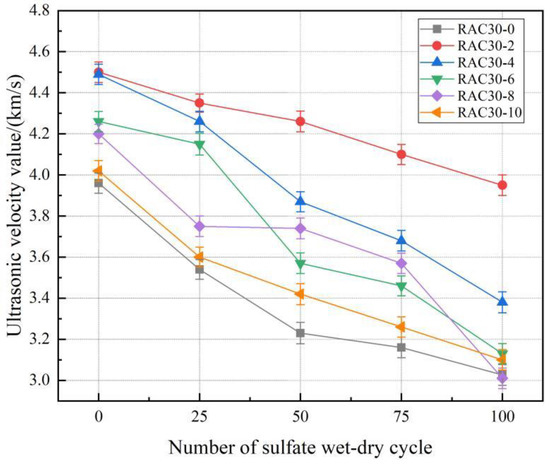
Figure 10.
Variation of ultrasonic sound velocity values of test blocks under different dry and wet cycle repetitions.
3.3. Enhancement Mechanism of NSRAC
3.3.1. Effect of NS on the Consistency and Slump of Concrete
Calcium hydroxide crystals are the hydration products of tricalcium silicate and dicalcium silicate during the hardening process of ordinary concrete. The water involved in the hydration reaction has two main parts, one is the interstitial water in the concrete, whose mass and volume depend on the settling density of the concrete, and the other part is related to the admixture and surface content of the cement, which is mainly influenced by the surface of the material and affects the fluidity of the concrete. Some researchers have pointed out that the slump of ordinary concrete is reduced by 40% and 60% after adding 2% and 4% of NS, respectively [32].
3.3.2. Effect of NS on the Hydration Reaction of Concrete
The adsorption of NS particles is strongly related to the reaction of volcanic ash. The process of cement hydrogenation produces a large amount of calcium hydroxide crystals (Equations (1) and (2)). Due to the reaction of NS with Ca(OH)2, the volcanic ash reaction leads to the formation of dense and high-strength C-H-S gels from Ca(OH)2 (Equation (3)). The gel fills the pores and increases the density of the additional areas, for which the strength of the concrete is improved.
Ca(OH)2 is a hexagonal crystal that exists in the transition zone between the cementitious material and the cement matrix and affects the strength and durability of concrete.
Finally, the violent reaction of NS particles is explained again, because NS has unsaturated binding or suspension, and the reaction steps between SiO2 are as follows.
(Equations (4)–(6)).
The reaction produces a C-H-S gel equivalent to 70% of the hydrogenated product, and the average diameter of the gel particles is about 10 nm. The nanoparticles themselves fill the pores of the C-H-S gel, forming a denser cement mortar.
As the size of SiO2 in the nanostructure decreases, many atoms are generated uniformly, thus increasing the chemical processes. NS has a huge surface energy, the particles are in a highly reactive state, and the reaction of atoms with other foreign atoms increases the volcanic ash reaction of NS [33].
3.4. CT Scan
Figure 11a,b show the CT scans of NSRAC at the pressure drop to 85% and the peak condition. The phenological phenomena of NSRAC after 25, 50, 75 and 100 repetitions of DWC are shown in Figure 12a, Figure 13a, Figure 14a and Figure 15a, and the results of CT scans of the same position for RAC30-4 are shown in Figure 12b, Figure 13b, Figure 14b and Figure 15b.

Figure 11.
NSRAC uncompressed and peak CT scans. (a) No pressure planing surface drawing. (b) Peak planing surface diagram.

Figure 12.
(a) Sulfate DWC at 25 repetitions phenological phenomena. (b) CT scan of RAC30-4 after 25 repetitions of DWC.
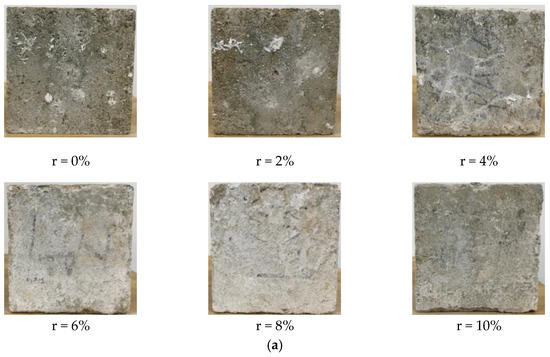
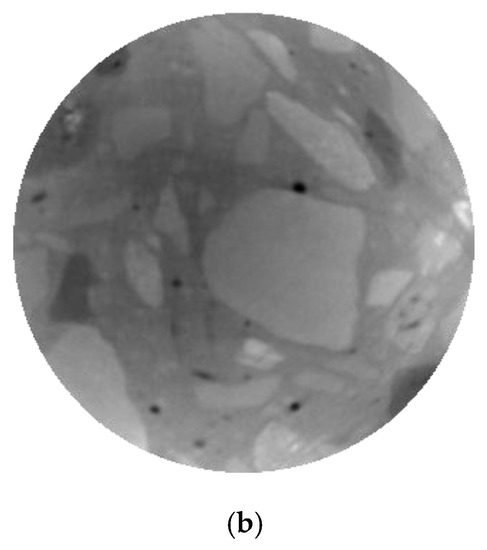
Figure 13.
(a) Sulfate DWC at 50 repetitions phenological phenomena. (b) CT scan of RAC30-4 after 50 repetitions of DWC.
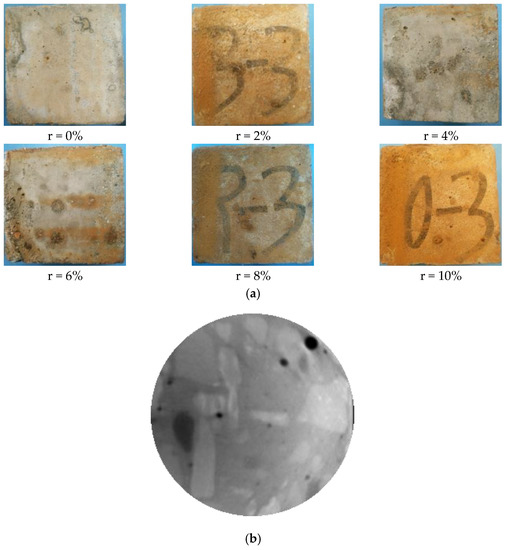
Figure 14.
(a) Sulfate DWC at 75 repetitions phenological phenomena. (b) CT scan of RAC30-4 after 75 repetitions of DWC.
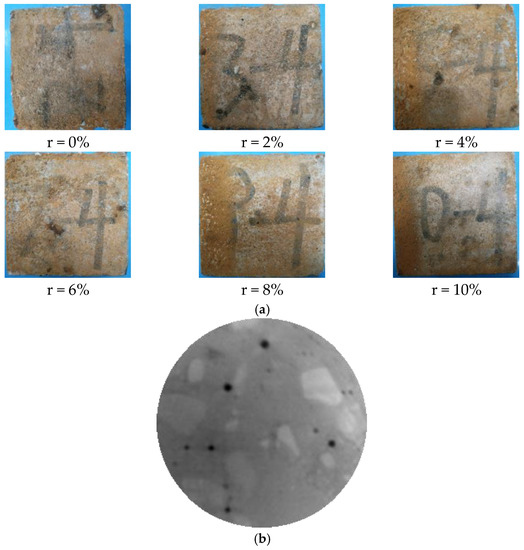
Figure 15.
(a) Sulfate DWC at 100 repetitions phenological phenomena. (b) CT scan of RAC30-4 after 100 repetitions of DWC.
3.4.1. Uniaxial Compression CT Scan
By comparing the profiles in both states in Figure 11a,b, there is a crack with an angle of 30° extending toward the interior of the concrete at the corner position of the concrete test block, and some cement mortar falls off at the corner position. From the comparative analysis, it can be concluded that the number of cracks in the concrete with added nanomaterials was significantly reduced, and the amount of cement mortar dislodged was less compared to that of ordinary concrete. Ordinary concrete can even see the location of the internal aggregates and the large separation of cement mortar from the aggregates, thus showing that, due to the special properties of NS, it can improve the physical and mechanical properties of concrete by increasing the bond between the internal aggregates and mortar, inhibiting the appearance of cracks and their expansion into the concrete. Therefore, by using NS as a special additive for concrete materials, it can effectively stop the sudden damage of concrete, ensure the accuracy of its compressive strength measurement and make the falling section longer.
3.4.2. The Same Number of Repetitions of DWC
In order to investigate in depth the variation of the effect of nanomaterial admixture on the number of voids and crack development in concrete, the effect of different nanomaterial admixtures on concrete properties at the same number of repetitions of DWC was selected.
The tomograms of the concrete modified with different doped nanomaterials after 25 repetitions of DWC are shown in Figure 12a,b. As can be seen from the figure, the outer layer of cement mortar is still intact, the outer ring is obviously regular, and there are only a few holes in its surface. This is due to the mortar outside the concrete directly exposed to the external environment, the moisture in the air and carbon dioxide, and a small reaction, resulting in the hardening of cement mortar, thermal expansion and contraction of the test block surface shrinkage, resulting in holes. After 25 repetitions of DWC, the hydration reaction in the gel system still took precedence relative to sulfate attack. Because after 25 repetitions of DWC, the results showed that the strength of all specimens was enhanced, but NSRAC had higher strength than normal RAC. From this, it can be concluded that NS has a positive effect on improving the strength of concrete.
Again, by comparing the tomographic scans of concrete modified with different doped nanomaterials after 50 repetitions of DWC, shown in Figure 13a,b, it can be seen from the concrete surface that the corrosion of the test blocks is much more severe than at 25 repetitions, with a significant increase in the number of holes on the sides, the beginning of small cracks and yellowish crystals in direct contact with the sulfuric acid solution. This is the result of the hydration reaction between the calcium ions in the capsule material and the sulfate ions in the solution, which produced calcium sulfate crystals. After the DWC, the concrete specimen was dried and soaked again during the process of being soaked, resulting in a yellowish precipitate on the surface. Therefore, at 50 repetitions of DWC, the strengthening effect of NS on concrete cannot resist the erosion ability of sulfate, but the strength and durability of NSRAC is still better than that of ordinary concrete.
Finally, the tomograms shown in Figure 14a,b and Figure 15a,b for the concrete modified with different NS after 75 and 100 repetitions of DWC were analyzed, and as the DWC gradually proceeded, the degree of erosion became stronger and more cracks appeared on the surface of the concrete specimens, and the aggregate at the edges separated from the cement paste, accompanied by cracks leading to the center of the specimens. It was concluded that the DWC of sulfuric acid caused severe damage to the specimens and that the concrete specimens with NS added were less damaged compared to the normal concrete specimens.
3.4.3. Different Number of repetitions of DWC
The first step is the 3D reconstruction of the image. After marking out the holes on each concrete slice through professional Avizo software processing, each slice can be combined and re-modeled so that a three-dimensional image consisting of hole connections can be seen and can be rotated arbitrarily to observe and analyze the development trend and damage of holes and cracks from different angles, and also the number of voids, porosity three-dimensional statistics and other data can be further modeled through three-dimensional analysis [34]. Then, the cracks or pores were observed by analyzing the NS with different admixtures at different number of repetitions of DWC. Then, the cracks or pores were observed by analyzing the NS with different admixtures at different number of repetitions of DWC. Table 7 and Figure 16 show the results of comparing the porosity of concrete with different amounts of NS at different numbers of repetitions of DWC.

Table 7.
Comparison of porosity of NSRAC with different number of repetitions of DWC (%).
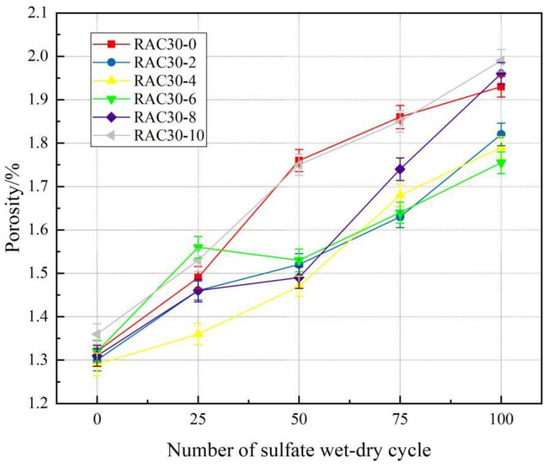
Figure 16.
Comparison of porosity of NSRAC with different numbers of repetitions of DWC.
Table 7 gives the comparative data of NS on the porosity of concrete with different admixtures, and then combined with Figure 16, it can be seen that the porosity corresponding to RAC30-4 are the lowest, and after different number of repetitions of DWC, the corrosion degree is gradually serious, and the porosity becomes larger accordingly. Therefore, it can also be concluded that the appropriate addition of nanomaterials can effectively improve the durability performance of concrete. The void diameters statistically derived during the 3D reconstruction are the values obtained by averaging a large number of irregularly shaped spheres, and the average diameters of NSRACs with different number of repetitions of DWC are compared in Table 8 and Figure 17.

Table 8.
Comparison of the average diameter of NSRAC with different numbers of repetitions of DWC (μm).
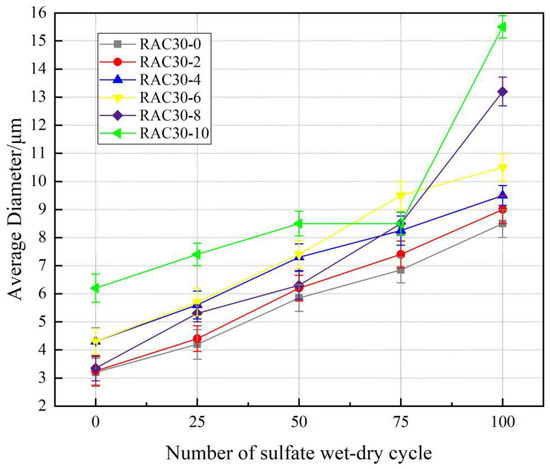
Figure 17.
Comparison of the average diameter of NSRAC with different numbers of repetitions of DWC.
From the data in Table 8, the variation of the average internal diameter of NSRAC under the corrosion effect of different numbers of repetitions of DWC is derived. From Figure 17, it can be seen that the volume growth of concrete with equal amount of NS added is relatively stable under different numbers of repetitions of DWC, and the irregular expansion of volume leads to relatively severe damage after 50 repetitions of DWC.
3.5. SEM
The macroscopic mechanical properties of an object are determined by its microstructure, so it is important to study the microstructure of a material to understand its macroscopic properties. Microscopic scanning electron microscopy was performed on sections of RAC with different NS replacement rates at a depth of 15 mm after 100 repetitions of DWC, and it can be seen from Figure 18 that NS has a significant effect on the microscopic morphology of recycled aggregate concrete.
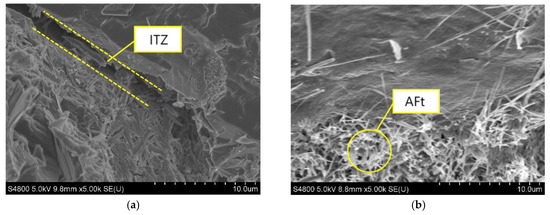

Figure 18.
Internal microstructure of NSRAC. (a) RAC30-0, (b) RAC30-4, (c) RAC30-2, (d) RAC30-4, (e) RAC30-8, (f) RAC30-10.
In terms of the interfacial structure of aggregate and mortar, it can be seen from Figure 18a,b that the addition of NS can make the interfacial structure of aggregate and mortar in RAC denser, and the hydrated calcium silicate gel in the ITZ is also more dense. In contrast, RAC without the addition of NS has a larger interfacial overrun zone and a loose and uncompact interfacial structure. The reason is that the addition of NS increases the content of reactive SiO2 in RAC. Due to the high volcanic ash activity and microfilling effect of SiO2, low-density continuous chain-like C-S-H gels can be generated by the secondary hydration reaction with calcium hydroxide, and these chain-like bodies are interconnected into a network structure to improve the interfacial overrun zone and make the interfacial structure denser.
From the effects of different doses of NS on the microstructure of RAC, the microstructures at 15 mm depth of RAC30-2, RAC30-4, RAC30-8 and RAC30-10 are shown in Figure 18c–f, respectively. It can be seen that the microstructure of RAC30-4 is the densest. When the nano-doping amount of SiO2 is 4%, the nano-induced hydration effect and volcanic ash effect can fully play a role in accelerating the hydration process, generating more hydration products, improving the interfacial structure, and finally forming a denser network structure in the hardened slurry, which enhances the resistance of RAC to sulfate erosion. However, when the NS dosage exceeds 4% to 8% or even 10%, the internal microstructure of RAC will be loosened instead. This is because the addition of excessive NS affects the hydration process of the cement. It can be seen that the addition of the appropriate amount of NS, can make the RAC more hydrated, and the hydration products fill the matrix interface, enhancing the resistance to sulfate attack.
4. Conclusions
In this study, 30% substitution rate of RAC was used, and mass loss rate, ultrasonic sound velocity value and residual compressive strength tests were performed with NS doping as the basic parameters to investigate the performance enhancement mechanism of NS on RAC and the resistance of NSRAC to sulfate and the corresponding damage mechanism. The main conclusions obtained from the results of this study are as follows:
- (1)
- As the number of repetitions of DWC increases, the calcium material in NSRAC generates a gel-like substance when interacting with sulfate, which makes the pores inside the specimen filled and the specimen mass increases. Since NS fills the microgaps and cracks in the concrete, the mass loss of RAC is effectively reduced, where the mass of RAC with 6% NS dosing is the largest at 50 repetitions of DWC. The 8% NS dosing had the best effect on reducing the mass loss of test blocks, and the lowest mass loss rate of RAC30-8 was 0.42% at 100 repetitions of DWC.
- (2)
- NS can improve the durability of RAC, the pressure corrosion coefficient and ultrasonic sound velocity values of NSRAC are generally higher than those of RAC, and the NS effect is more obvious as the number of repetitions of DWC increases. The best performance was achieved in the compressive strength test of RAC at 4% NS content, which was 20% higher than RAC on average. The RAC ultrasonic sound velocity values at 2% NS content were the highest, at 13%, 22%, 31%, 29%, and 30% higher than the RAC.
- (3)
- CT results showed that the hydration reaction in the gel system was greater than sulfate erosion at 25 repetitions of DWC, and after 50–100 repetitions of DWC, the enhancement effect of NS on RAC was less than the erosion ability of sulfate, but the strength and durability of NSRAC were still better than RAC, and with NS addition of 4%, the porosity is the minimum. After 50 repetitions of DWC, the volume of RAC30-8 and RAC30-10 expanded irregularly, resulting in relatively severe damage.
- (4)
- SEM after 100 repetitions of DWC showed that NS made the C-S-H gel interfacial structure at the interface of RAC and mortar and the excess zone more dense, and 4% NS could accelerate the hydration process better compared with other admixtures. When NS is added in excess, it loosens the internal microstructure of concrete. Compared with rubber-modified recycled concrete, 4% NS improved the pore structure of RAC more significantly than 4% rubber. Finally, considering the mechanical properties of NSRAC, it is not recommended to dose more than 4% of NS.
- (5)
- The limitation of this study is that only 30% RAC substitution rate was used in NSRAC, and it is necessary to use more different RAC substitution rates. In addition, the application of NS in engineering will become more and more common, and the presence of many other corrosive substances in the complex marine environment that affect the safety of concrete structures allows further research on the durability of NSRAC in the Cl- environment.
Author Contributions
Conceptualization, J.L. (Jia Luo) and S.W.; Software, F.X.; Validation, J.L. (Jia Luo); Formal analysis, J.L. (Jia Luo) and X.Q.; Investigation, J.L. (Jia Luo), J.L. (Juntao Li), K.L. and Z.H.; Resources, S.W., X.Q., J.X. and K.L.; Data curation, J.L. (Jia Luo), X.Q., J.L. (Juntao Li), F.X. and Z.H.; Writing—original draft, J.L. (Jia Luo); Writing—review & editing, J.L. (Jia Luo), S.W. and X.Q.; Visualization, S.W.; Supervision, S.W.; Project administration, X.Q.; Funding acquisition, S.W. and J.X. All authors have read and agreed to the published version of the manuscript.
Funding
This research was funded by [National Natural Science Foundation of China] grant number [No. 51678480], [Natural Science Basic Research Program of Shaanxi Province] grant number [2023-JC-QN-0553] and [Project on Key Research and Development of Shaanxi, China] grant number [No. 2021SF-521]. The APC was funded by [Prof. She-Liang Wang].
Data Availability Statement
Data from the study cannot be made public at this time for privacy reasons.
Acknowledgments
We thank SheLiang Wang, Xiaoyi Quan and all the researchers involved for their joint efforts.
Conflicts of Interest
The authors declare no conflict of interest.
Abbreviations
| NS | nano-SiO2 |
| RAC | recycled aggregate concrete |
| NSRAC | nano-SiO2-modified recycled aggregate concrete |
| DWC | dry-wet cycle |
| ITZ | interface transition zone |
| CT | industrial computed tomography |
| FDN-C | naphthalene-based high-efficiency water-reducing agent |
| NC | natural concrete |
| W | water |
| C | cementitious material |
| NSSR | nano-SiO2 substitution rate |
| RCA | recycled Coarse Aggregate |
| NCA | natural coarse aggregates |
| CWC | calculated water consumption |
| AWC | additional water consumption |
| RDME | relative dynamic modulus of elasticity |
| C3S | tricalcium silicate |
| C-S-H | calcium silicate hydrate |
| Si-OH | silicon hydroxide |
| 2D | two-dimensional |
| 3D | three-dimensional |
| SEM | scanning electron microscope |
References
- Aslani, F.; Deghani, A.; Asif, Z. Development of Lightweight Rubberized Geopolymer Concrete by Using Polystyrene and Recycled Crumb-Rubber Aggregates. J. Mater. Civ. Eng. 2020, 32, 04019345. [Google Scholar]
- Ayoub, D.; Farhad, A.; Neda, G.P. Effects of initial SiO2/Al2O3 molar ratio and slag on fly ash-based ambient cured geopolymer properties. Constr. Build. Mater. 2021, 293, 123527. [Google Scholar]
- Farhad, A.; Ayoub, D.; Lining, W. The effect of hollow glass microspheres, carbon nanofibers and activated carbon powder on mechanical and dry shrinkage performance of ultra-lightweight engineered cementitious composites. Constr. Build. Mater. 2021, 280, 122415. [Google Scholar]
- Jianqun, W.; Long, L.; Longwei, Z.; Bei, L.; Renjian, D.; Defeng, S. Sustainable Applications for Utilizing Antimony Tailing Coarse Aggregate (ATCA) in Concrete: Characteristic of ATCA and Toxicity Risks of Concrete. Materials 2021, 14, 5480. [Google Scholar]
- Junbo, S.; Yufei, W.; Shukui, L.; Ayoub, D.; Xiaolei, X.; Jianjun, W.; Xiangyu, W. Mechanical, chemical and hydrothermal activation for waste glass reinforced cement. Constr. Build. Mater. 2021, 301, 124361. [Google Scholar]
- Long, L.; Jianqun, W.; Longwei, Z.; Renjian, D.; Saijun, Z.; Gongxun, W. Strength and Durability Properties of Antimony Tailing Coarse Aggregate (ATCA) Concrete. Materials 2021, 14, 5606. [Google Scholar]
- Peirovi, M.; Labafzadeh, M.S.; Dehghani, A.; Meftahi, F. Durability and mechanical properties of precast concrete curb containing waste copper slag. Mag. Concr. Res. 2018, 71, 567–576. [Google Scholar]
- Qi, B.; Gao, J.M.; Shen, D.M. Study of sulfate transport properties in recycled concrete under the action of dry and wet cycles. Concr. Cem. Prod. 2017, 7, 6–10. [Google Scholar] [CrossRef]
- Xu, Y.Q.; Li, S.G.; Wang, J.; Ping, X. Study on the effect of nanomaterials on the durability and functionality of concrete. Hydropower Technol. 2017, 48, 208–215. [Google Scholar] [CrossRef]
- Duan, Q.; Ding, H.Z.; Yang, Z.W.; Zhou, B.L. Study on mechanical properties of concrete subjected to sulfate attack. Constr. Technol. 2017, 1, 62–64. [Google Scholar]
- Feng, W.; Wang, Y.; Sun, J.; Tang, Y.; Wu, D.; Jiang, Z.; Wang, J.; Wang, X. Prediction of thermo-mechanical properties of rubber-modified recycled aggregate concrete. Constr. Build. Mater. 2022, 318, 125970. [Google Scholar]
- Yunchao, T.; Wanhui, F.; Zheng, C.; Yumei, N.; Shuhong, G.; Junbo, S. Fracture behavior of a sustainable material: Recycled concrete with waste crumb rubber subjected to elevated temperatures. J. Clean. Prod. 2021, 318, 128553. [Google Scholar]
- Feng, W.; Tang, Y.; Yang, Y.; Cheng, Y.; Qiu, J.; Zhang, H.; Isleem, H.F.; Tayeh, B.A.; Namdar, A. Mechanical behavior and constitutive model of sustainable concrete: Seawater and sea-sand recycled aggregate concrete. Constr. Build. Mater. 2023, 364, 130010. [Google Scholar]
- Rahimzadeh, C.Y.; Ahmed, S.; Barzinjy, A.A. Systematic Multiscale Models to Predict the Compressive Strength of Cement Paste as a Function of Microsilica and Nanosilica Contents, Water/Cement Ratio, and Curing Ages. Sustainability 2022, 14, 1723. [Google Scholar]
- Huang, Z. Research on Mechanical Properties and Durability of Nanoconcrete; Shenyang University: Shenyang, China, 2016. [Google Scholar]
- Gao, D.Y.; Li, H. Uniaxial compressive stress-strain relationship for fiber nanoconcrete after high temperature. J. Civ. Eng. 2015, 48, 10–20. [Google Scholar] [CrossRef]
- Li, F.Y.; Lou, X. Research on the application of inorganic nanomaterials in shotcrete. Low Carbon World 2016, 31, 161–162. [Google Scholar]
- Li, W.G.; Long, C.; Luo, Z.Y.; Huang, Z.Y. Study on the damage mechanism of nano-modified recycled aggregate concrete. J. Constr. Mater. 2017, 20, 685–691+786. [Google Scholar]
- Zhu, J.P.; Hou, H.H.; Feng, M.M.; Tian, M.D.; Chang, D.H.; Zhang, H.; Chao, T.T. Research progress on the application of nanotitanium dioxide in silicate industry. Silic. Bull. 2016, 35, 2847–2851+2859. [Google Scholar]
- Ali, R.; Muayad, M.; Mohammed, A.S.; Asteris, P.G. Analysis and prediction of the effect of Nanosilica on the compressive strength of concrete with different mix proportions and specimen sizes using various numerical approaches. Struct. Concr. 2022. [Google Scholar] [CrossRef]
- Huo, J.M.; Ding, Q. Effect of nanomaterials on the dry and wet corrosion cycle performance of rubber recycled concrete. Concr. Cem. Prod. 2016, 27–31. [Google Scholar] [CrossRef]
- Faraj, R.H.; Mohammed, A.A.; Mohammed, A.; Omer, K.M.; Ahmed, H.U. Systematic multiscale models to predict the compressive strength of self-compacting concretes modified with nanosilica at different curing ages. Eng. Comput. 2021, 38, 2365–2388. [Google Scholar]
- Li, Z.Y.; Yang, L.; Tu, L.Q.; Qin, M.Q.; Ye, Z.K. Effect of nanohydrated calcium silicate on the durability of concrete. Concrete 2013, 10, 112–114+118. [Google Scholar]
- Unis, A.H.; Azad, A.M.; Salih, M.A. Effectiveness of nano-SiO2 on the mechanical, durability, and microstructural behavior of geopolymer concrete at different curing ages. Arch. Civ. Mech. Eng. 2023, 23, 129. [Google Scholar]
- Liu, D.W.; Liu, B.Y.; Li, X.D.; Yuan, J. Study on the performance of concrete under the coupling effect of sulfate and dry and wet cycles. J. Water Resour. Water Transp. Eng. 2015, 4, 69–74. [Google Scholar]
- GB 50119-2013; Concrete Admixture Application Technical Specifications. China Architecture & Building Press: Beijing, China, 2013.
- Wen, H. Experimental Study on Recycled Aggregate Concrete; Hebei University of Engineering: Handan, China, 2018. [Google Scholar]
- GB 50164-2011; Concrete Quality Control Standards. China Architecture & Building Press: Beijing, China, 2011.
- GB 11975-1989; Aerated Concrete Dry and Wet Cycle Test Method. Standard Press of China: Beijing, China, 1990.
- CECS 02-2005; Ultrasonic Rebound Synthesis Method for Testing the Strength of Concrete Technical Regulations. China Association for Engineering Construction Standardization: Beijing, China, 2005.
- GB/T 50081-2002; General Concrete Mechanical Properties Test Method Standard. China Architecture & Building Press: Beijing, China, 2003.
- Tian, W.; Dang, F.N.; Chen, H.Q. Fractal analysis of concrete fine fracture based on CT image processing technology. J. Appl. Basic Eng. Sci. 2012, 20, 424–431. [Google Scholar]
- Yuan, X.L.; Li, B.X. Effect of Fly Ash and Early Strength Agent on Durability of Concrete Exposed to the Cyclic Sulfate Environment. J. Wuhan Univ. Technol. 2010, 25, 1065–1069. [Google Scholar]
- Huang, Z.; Xing, F.; Dong, B.Q.; Yin, H.; Luo, S. Study of sulphate corrosion of concrete under load. Concrete 2008, 2, 66–69. [Google Scholar]
Disclaimer/Publisher’s Note: The statements, opinions and data contained in all publications are solely those of the individual author(s) and contributor(s) and not of MDPI and/or the editor(s). MDPI and/or the editor(s) disclaim responsibility for any injury to people or property resulting from any ideas, methods, instructions or products referred to in the content. |
© 2023 by the authors. Licensee MDPI, Basel, Switzerland. This article is an open access article distributed under the terms and conditions of the Creative Commons Attribution (CC BY) license (https://creativecommons.org/licenses/by/4.0/).